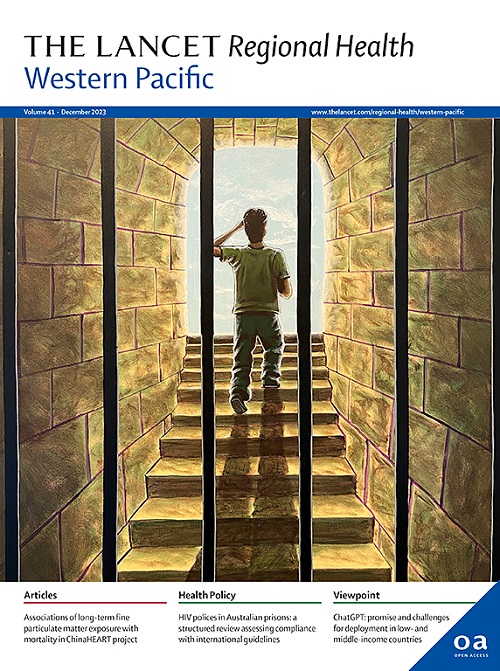Evaluation of the safety and immunogenicity of a 9-valent human papillomavirus vaccine produced in Saccharomyces cerevisiae using a heating–chilling process for virus-like particle antigen assembly: a double-blind, randomized, placebo-controlled phase 1 clinical trial
IF 8.1
1区 医学
Q1 HEALTH CARE SCIENCES & SERVICES
引用次数: 0
Abstract
Background
It is challenging to secure the tertiary structure of virus-like particles (VLPs) during manufacturing process development. In this study, we evaluated the safety and immunogenicity of PV-001, a 9-valent human papillomavirus (HPV) vaccine candidate manufactured in Saccharomyces cerevisiae using a new heating–chilling process designed to yield L1 VLPs with high purity and homogeneity.
Methods
The 9-valent vaccine formulation contained L1 VLPs for HPV types 6, 11, 16, 18, 31, 33, 45, 52, and 58. A double-blind, randomized clinical trial was conducted in which participants were assigned in a 1:1 ratio to receive either the investigation vaccine or a placebo consisting solely of aluminum phosphate (AP) gel, used as an adjuvant. A total of 41 healthy women aged 19–45 years were enrolled in South Korea and administered the assigned intervention via intramuscular injection at 0, 2, and 6 months. Safety assessments included immediate adverse events (AEs), solicited local and systemic AEs, and unsolicited AEs. Immunogenicity was evaluated by measuring serum anti-HPV L1 VLP IgG and neutralizing antibody titers pre- and post-vaccination (ClinicalTrials.gov: NCT07081334).
Findings
No serious adverse events (AEs) were reported following administration of PV-001, and the overall safety profile was consistent with expected findings, supporting the favorable clinical safety of PV-001. Robust increases in both anti-HPV L1 VLP IgG and neutralizing antibody titers were observed for all nine HPV types following the second and third vaccine doses, relative to baseline.
Interpretation
PV-001 was well tolerated and elicited strong immunogenic responses, supporting its potential for further clinical development and the evaluation of broader target populations and age groups.
Funding
This research was supported by a grant of the Korea Health Technology R&D Project through the Korea Health Industry Development Institute (KHIDI), funded by the Ministry of Health & Welfare, Republic of Korea (grant number: RS-2023-KH134909).
采用加热-冷却工艺制备病毒样颗粒抗原组装的9价人乳头瘤病毒疫苗的安全性和免疫原性评价:一项双盲、随机、安慰剂对照的1期临床试验
病毒样颗粒(vlp)的三级结构在制造工艺开发中具有挑战性。在这项研究中,我们评估了PV-001的安全性和免疫原性,PV-001是一种9价人乳头瘤病毒(HPV)候选疫苗,在酿酒酵母中使用一种新的加热-冷却工艺生产,旨在产生高纯度和均匀性的L1 VLPs。方法制备的9价HPV疫苗含有6、11、16、18、31、33、45、52、58型的L1 VLPs。进行了一项双盲随机临床试验,参与者以1:1的比例被分配接受调查疫苗或仅由磷酸铝(AP)凝胶组成的安慰剂,用作佐剂。在韩国共有41名年龄在19-45岁的健康女性被招募,并在0、2和6个月时通过肌肉注射给予指定的干预措施。安全性评估包括即时不良事件(ae)、征求的局部和全身ae以及非征求的ae。免疫原性通过测定接种前后血清抗hpv L1 VLP IgG和中和抗体滴度来评估(ClinicalTrials.gov: NCT07081334)。使用PV-001后未报告严重不良事件(ae),总体安全性与预期结果一致,支持PV-001良好的临床安全性。与基线相比,在第二次和第三次疫苗剂量后,所有九种HPV类型的抗HPV L1 VLP IgG和中和抗体滴度均显著增加。pv -001耐受性良好,引发了强烈的免疫原性反应,支持其进一步临床开发的潜力,以及对更广泛的目标人群和年龄组的评估。本研究由大韩民国卫生福利部资助的韩国健康产业发展研究所(KHIDI)的韩国健康技术研发项目资助(批准号:RS-2023-KH134909)。
本文章由计算机程序翻译,如有差异,请以英文原文为准。
求助全文
约1分钟内获得全文
求助全文
来源期刊

The Lancet Regional Health: Western Pacific
Medicine-Pediatrics, Perinatology and Child Health
CiteScore
8.80
自引率
2.80%
发文量
305
审稿时长
11 weeks
期刊介绍:
The Lancet Regional Health – Western Pacific, a gold open access journal, is an integral part of The Lancet's global initiative advocating for healthcare quality and access worldwide. It aims to advance clinical practice and health policy in the Western Pacific region, contributing to enhanced health outcomes. The journal publishes high-quality original research shedding light on clinical practice and health policy in the region. It also includes reviews, commentaries, and opinion pieces covering diverse regional health topics, such as infectious diseases, non-communicable diseases, child and adolescent health, maternal and reproductive health, aging health, mental health, the health workforce and systems, and health policy.
 求助内容:
求助内容: 应助结果提醒方式:
应助结果提醒方式:


